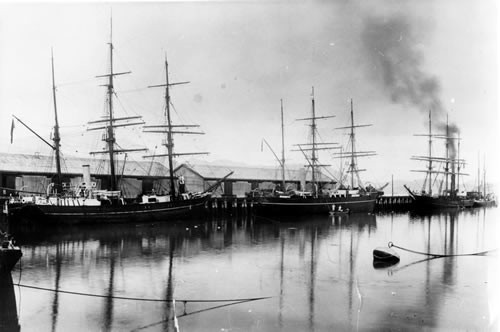
Morning, Discovery and Terra Nova at the Port of Lyttelton during the British Antarctic Expedition, 1901-1904.
NZ ports used by Antarctic expeditions
Three New Zealand ports feature prominently in the history of Antarctic expeditions. The Port of Lyttelton predominated as a New Zealand base for expeditions, but Port Chalmers and the Port of Wellington were also used for this purpose and all were the sites of numerous other brief visits.
Port Chalmers
Port Chalmers can lay claim to the earliest visit from an Antarctic expedition. In November 1894 it hosted men from the Norwegian whaling and sealing ship Antarctic who in January 1895 made the first substantiated landing on the Antarctic continent proper. The port attracted further visits from Antarctic expeditions by making generous offers of goods and services. Robert Scott visited the port with both his Discovery and Terra Nova expeditions, lured by the promise of free coal from the Mayor and coal merchant, John Mill. Ernest Shackleton's Nimrod and Endurance expeditions also received assistance from the port. But it wasn't until 1928 that Port Chalmers was first used as the New Zealand base for an Antarctic expedition, by American aviator and explorer Richard E. Byrd.
Byrd had gratefully accepted the Otago Harbour Board's offer of free use of the harbour, wharf sheds and docking facilities. The expedition also benefited from the contributions of local businesses – everything from a year's free frozen storage to chocolate. The Harbour Board made the same offer to another American, Lincoln Ellsworth, who used the port for his Antarctic expedition in 1933. Future Byrd-led expeditions visited Port Chalmers, as did American, New Zealand and French expeditions associated with the International Geophysical Year 1957-58. The port's emergency assistance to United States Navy vessels during the initial stages of Operation Deep Freeze led to it being used between 1956 and 1967 as the base for the ‘picket ships’ which supported flights between New Zealand and the Antarctic.
Death at the port
Twenty-three year old seaman Charles Bonner fell from the top of the mainmast of the Discovery as it was leaving the Port of Lyttelton on 21 December 1901. He was buried in the Port Chalmers cemetery two days later, following an inquest into his death.
Port of Lyttelton
Scott and Shackleton chose the Port of Lyttelton as the New Zealand base for their Discovery, Nimrod and Terra Nova expeditions. Scott was reportedly given two choices of base for his first expedition: Melbourne and Christchurch - each of which had a magnetic observatory. He may have chosen Christchurch simply because it was closer to the Antarctic, but the presence of his cousin, R.J. Scott, a Professor of Engineering at the University of Canterbury, may also have had an influence. As in Port Chalmers, there were generous offers of goods and services from the Harbour Board and local businesses. Scott and Shackleton were rewarded with similar generosity on their subsequent expeditions, as was the Australasian Antarctic Expedition when its ship the Aurora called at Lyttelton in 1912.
Money, money, money
A 2007 study carried out by Lincoln University estimated that Antarctic-related activities directly contribute $88 million each year to the Canterbury region, with an indirect benefit of $155 million. They directly contribute $133 million to the New Zealand economy, with an indirect benefit of $282 million.
It wasn't until the initial stages of Operation Deep Freeze that Christchurch began to be heavily used again. Harewood Airport, now Christchurch International Airport, was the base for 14 of the aircraft involved in the first flights between New Zealand and the Antarctic in December 1955 (four others were based at Taieri Airport, near Dunedin), while Lyttelton was the base for seven supporting United States Navy vessels. Operation Deep Freeze was subsequently supported by many New Zealand ports, but its New Zealand base remained in Christchurch. Regular support missions continue to be flown from the airport, while the port is used to refuel and replenish supply vessels.
Port of Wellington
The Port of Wellington had brief visits from Antarctic expeditions in the 1910s. The Japanese Antarctic Expedition's ship, the Kainan Maru, called into Wellington for fuel and supplies on its way to and from the Antarctic between 1912 and 1914. The port also welcomed Shackleton's Aurora when it returned from rescuing the Ross Sea Party in February 1917. But again it was Byrd who first used Wellington as a New Zealand base - for his second Antarctic expedition of 1933-35.
The 1950s was a growth period for Wellington's Antarctic connections. Four United States Navy vessels supporting flights to the Antarctic were based there during the initial stages of Operation Deep Freeze in 1955. Then in April 1956 the Russian Antarctic Expedition's supply ship, Ob, visited the port. In December the same year the port was the site for the official farewell to New Zealand's first Antarctic expedition. Their support vessel, HMNZS Endeavour, returned to the port in March 1957 and again in March 1958, this time bearing a triumphant Sir Edmund Hillary and Sir Vivian Fuchs.
Further information
Books
- Ian Church, Last port to Antarctica: Dunedin and Port Chalmers: 100 years of service, Otago Heritage Books, Dunedin, 1997
- A. Leigh Hunt, My second home: Admiral Byrd & New Zealand, A Hunt, Wellington, 1968
- L. B. Quartermain, New Zealand and the Antarctic, A R Shearer, Government Printer, Wellington, 1971
- W H Scotter, A history of Port Lyttelton, The Lyttelton Harbour Board, Christchurch, 1968
Links
- Antarctic Support Ship HMNZS Endeavour (New Zealand Antarctic Society)
- The reluctant hosts: Soviet expedition ships (Cambridge Journals)
- Antarctic mid winter function (Christchurch City Council)





Community contributions